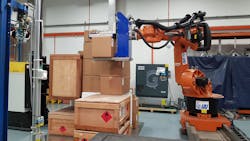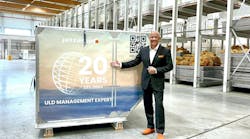A team of ST Engineering and Israel Aerospace Industries (IAI) won the Aviation Challenge 2 Program (AC2) in Singapore.
IAI and ST Engineering presented the Civil Aviation Authority of Singapore (CAAS) with a comprehensive automated innovative solution that improves build-up and breakdown of cargo ULD (Unit load Device) pallets and containers, a labor-intensive process at Changi Airfreight Center. The system will dramatically reduce the manpower and manual movements of heavy cargo around the terminal.
This is the second consecutive win for the ST Engineering and IAI team, following their August win of the Aviation Challenge 1 Program (AC1). IAI andST Engineering presented CAAS with a comprehensive solution for improving baggage handling for both outgoing and incoming flights at Changi Airport. The system dramatically improves the passenger experience by reducing baggage loss and damages.
Thirteen international and local teams/companies submitted proposals to the Aviation Challenge 2 (AC2). Two were selected for the final stage of building a full-scale "proof-of concept" demonstration system, with funding from CAAS. The competition ended today with the announcement of the winning team of ST Engineering and IAI, which submitted the most operational and cost effective end-to-end solution.
About the system
From the point where cargo shipments enter the terminal, up to the point where the completed pallet/container is ready to be transported and loaded into the aircraft, the system moves it through the following four major sequences : (i) Fully-automated scanning station that determines the airway bill (I.D.), weight and dimensions of the cargo item and feed the information into a computerized database, (ii) Transfer of the cargo item from the scanning station to a temporary storage area by using forklift-based automated/manual guided vehicle, (iii) Data processing performed by a unique load planning optimization engine, which generates an optimized loading sequence to maximize the volumetric utilization per pallet/container, (iv) Once the optimized load plan has been generated, the physical build-up command is been called for a robotic station to automatically perform the build-up activity using forklift-based automated guided vehicle and robotic arm. The robot is equipped with a unique adjustable gripper that can safely handle a wide variety of items (including odd shapes and various weights and materials). Another unique feature of the ST Engineering and IAI solution brings a full end-to-end solution for the entire cargo handling process.
From a wider business perspective, in this demonstration IAI and ST Engineering successfully addressed the growing need for automating the manpower-intensive process of consolidating cargo into larger pallets and containers for air transport at Changi Airport. Concurrently, robotization of the build-up and breakdown of cargo pallets and containers is the key focus area. This is due to the fact that the consolidation and removal of cargo from ULD containers and pallets is currently performed manually in most cargo hub terminals in the world. The presented automated cargo handling system aims to minimize the physical workload of cargo handlers and by that meets also the latest compliance regarding personnel health and safety. Utilizing a combination of scanners, robotic manipulators and automated guided vehicles, parallel build-up of ULDs can be achieved, potentially realizing up to 30 percent reduction in the workload as compared to the current manual process.
IAI and ST Engineering’s system offers several unique advantages to Changi Airport Cargo Center, including:
- Enhancing cargo operations by reducing overall reliance on manual physical labor
- Realizing an overall improvement in process efficiency
- Minimal impact on existing infrastructure in the cargo terminals
- Very adaptive, can be easily fitted into an extensive variety of terminal building configurations
- Ensures low life-cycle operating costs
- Improved traceability of cargo items, preventing cargo items loss
- Improved safety of ground staff during operation and processing
- Easy operation eliminates the need in extensive training or technical know-how
- Improved loading efficiency by means of unique load-planning optimization engine





